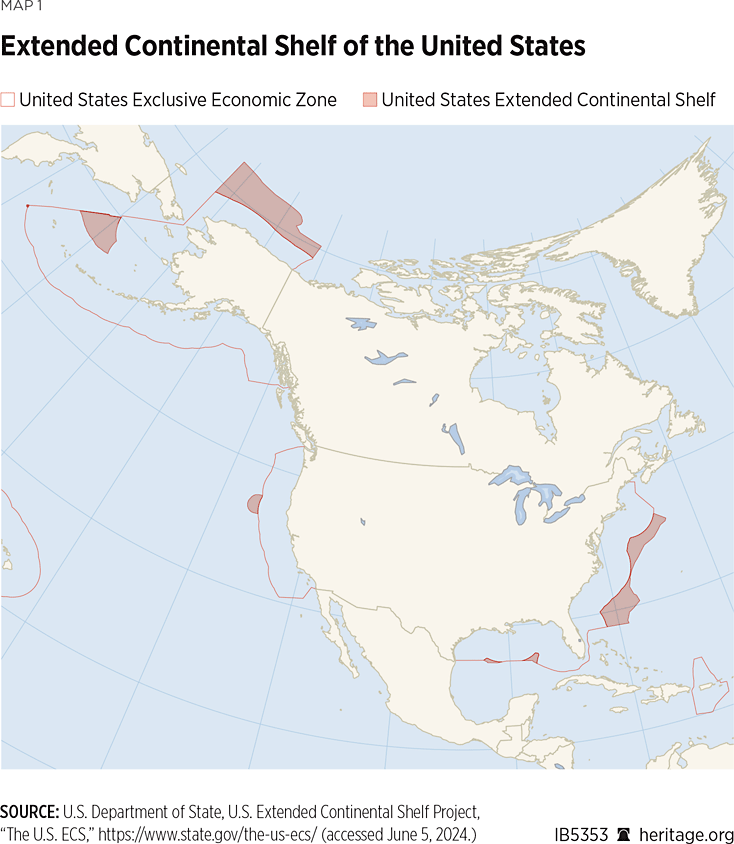For more than 20 years, the United States has collected bathymetric and seismic mapping data on the outer margins of its continental shelf at locations around the world. The work of the U.S. Extended Continental Shelf Project, an interagency effort led by the U.S. Department of State, was recently completed.REF On December 19, 2023, the State Department publicly released “the geographic coordinates defining the outer limits of the U.S. continental shelf in areas beyond 200 nautical miles from the coast, known as the extended continental shelf (ECS).”REF
Consistent with past practice relating to the U.S. continental shelf and maritime resources, the Biden Administration should issue an official proclamation regarding the U.S. ECS, its boundaries, and its resources.
The U.S. Extended Continental Shelf
The ECS is defined as any segment of continental shelf that extends beyond the 200 nautical mile (nm) exclusive economic zone (EEZ) that meets certain criteria relating to depth and thickness.REF The U.S. ECS Project identified more than 380,000 square miles of continental shelf that qualifies as ECS—an area more than twice the size of California. The U.S. ECS is located in seven different regions around the world, including large areas in the Arctic Ocean, in the Bering Sea, and off the Atlantic Coast, as well as smaller areas off the Pacific Coast, adjacent to the Mariana Islands, and in the Gulf of Mexico.

The value of the resources associated with the U.S. ECS (such as oil and natural gas) is difficult to estimate but is likely substantial. According to the ECS Task Force, “[g]iven the size of the U.S. ECS, the energy, mineral, and living resources may be worth many billions if not trillions of dollars.”REF
It therefore behooves the President to proclaim both to neighboring countries and to the broader “international community” that the U.S. asserts jurisdiction over and control of its ECS resources. Such a proclamation would be consistent with actions taken by previous U.S. Presidents.
Historical Practice
Since 1945, the U.S. has taken unilateral action to define its maritime boundaries as well as its rights to the resources of its continental shelf. None of these actions has been challenged by any nation, any group of nations, or the international community as a whole.
1945: On September 28, 1945, President Harry S. Truman issued two proclamations. One of these proclamations, “Policy of the United States with Respect to the Natural Resources of the Subsoil and Sea Bed of the Continental Shelf,” states in part:
Having concern for the urgency of conserving and prudently utilizing its natural resources, the Government of the United States regards the natural resources of the subsoil and sea bed of the continental shelf beneath the high seas but contiguous to the coasts of the United States as appertaining to the United States, subject to its jurisdiction and control.REF
Truman’s second proclamation established a conservation zone for U.S. fishery resources contiguous to the U.S. coast.REF
1953: Congress refined Truman’s continental shelf proclamation in 1953 when it enacted the Outer Continental Shelf Lands Act, which declared it to be “the policy of the United States” that “the subsoil and seabed of the outer Continental Shelf appertain to the United States and are subject to its jurisdiction, control, and power of disposition”REF and defined the outer continental shelf as “all submerged lands lying seaward and outside of the area of lands beneath navigable waters.”REF
1983: Having decided in July 1982 not to sign the United Nations Convention on the Law of the Sea (UNCLOS), President Ronald Reagan announced a U.S. oceans policy in March 1983. The announcement proclaimed “an Exclusive Economic Zone in which the United States will exercise sovereign rights in living and nonliving resources within 200 nautical miles of its coast.”REF The pronouncement of the 200 nm EEZ was part of Reagan’s broader policy commitment to “accept[ing] and act[ing] in accordance with the balance of interests relating to traditional uses of the oceans,” which are reflected in UNCLOS. The 200 nm EEZ conforms to the limit set forth in Article 57 of the convention.
1988: In December 1988, Reagan followed up his 1983 EEZ proclamation by extending the breadth of the U.S. territorial sea from three nm to 12 nm in conformity with Article 3 of UNCLOS.REF
1999: In September 1999, building on Reagan’s maritime proclamations, President Bill Clinton proclaimed an extension of the U.S. contiguous zone from nine nm to 24 nm in conformity with Article 33(2) of UNCLOS.REF
Now that the full extent of the U.S. ECS has been mapped and demarcated by the U.S., President Biden should issue a similar proclamation confirming U.S. jurisdiction over and control of the ECS and all of its resources. While such a proclamation is not strictly necessary and is redundant to the Truman proclamation, the Outer Continental Shelf Lands Act, and other U.S. policy statements, it would clarify to neighboring nations and the international community that the U.S. is asserting specific jurisdiction over its ECS, consistent with customary international law and UNCLOS.
UNCLOS Ratification Unnecessary
The Biden Administration should issue an ECS proclamation regardless of U.S. non-membership in UNCLOS—a deeply flawed treaty that the U.S. should avoid joining at all costs.
Ratifying UNCLOS would result in the U.S. transferring billions of dollars in offshore oil and gas royalties to an unaccountable international organization in Jamaica that in turn is empowered to redistribute those American dollars to other nations as it sees fit.REF Also, the convention’s mandatory dispute resolution mechanisms allow baseless and costly environmental lawsuits to be brought against the U.S. for allegedly contributing to global warming.REF
In any event, membership in UNCLOS is not needed to secure America’s rights to its ECS. Like Presidents Truman, Reagan, and Clinton, President Biden has the authority to issue a proclamation noting the coordinates of the U.S. ECS and declaring U.S. jurisdiction over it and all of its resources.
Conclusion
The United States is not likely to accede to UNCLOS in the near term, or perhaps ever. However, this does not mean that the United States should not take every action necessary to secure its ECS resources in the Arctic Ocean, in the Gulf of Mexico, and throughout the world. The United States can accomplish this while acting as a sovereign nation, continuing the tradition of American Presidents in proclaiming the nation’s maritime and resource rights, and without acceding to UNCLOS.
Steven Groves is the Margaret Thatcher Fellow in the Margaret Thatcher Center for Freedom at The Heritage Foundation.




